Patanjali's Strategic Management: Growth, Market Analysis & Business
VerifiedAdded on 2021/08/06
|22
|5200
|270
Report
AI Summary
This report provides a comprehensive strategic analysis of Patanjali Ayurved Limited, focusing on its remarkable growth trajectory and the strategies employed to disrupt the Indian FMCG market. It delves into Patanjali's growth hacking strategy, highlighting the roles of Swami Ramdev and the integration of marketing, data, and technology. The report also presents a PESTLE analysis, examining the political, economic, social, technological, legal, and environmental factors influencing Patanjali's operations. Furthermore, it applies Porter's Five Forces model to assess the competitive landscape, including the rivalry among competitors, the threat of new entrants, the bargaining power of suppliers and buyers, and the threat of substitute products. The analysis extends to Patanjali's vision, mission, strategic drift, and business model canvas, providing a holistic understanding of the company's strategic management.
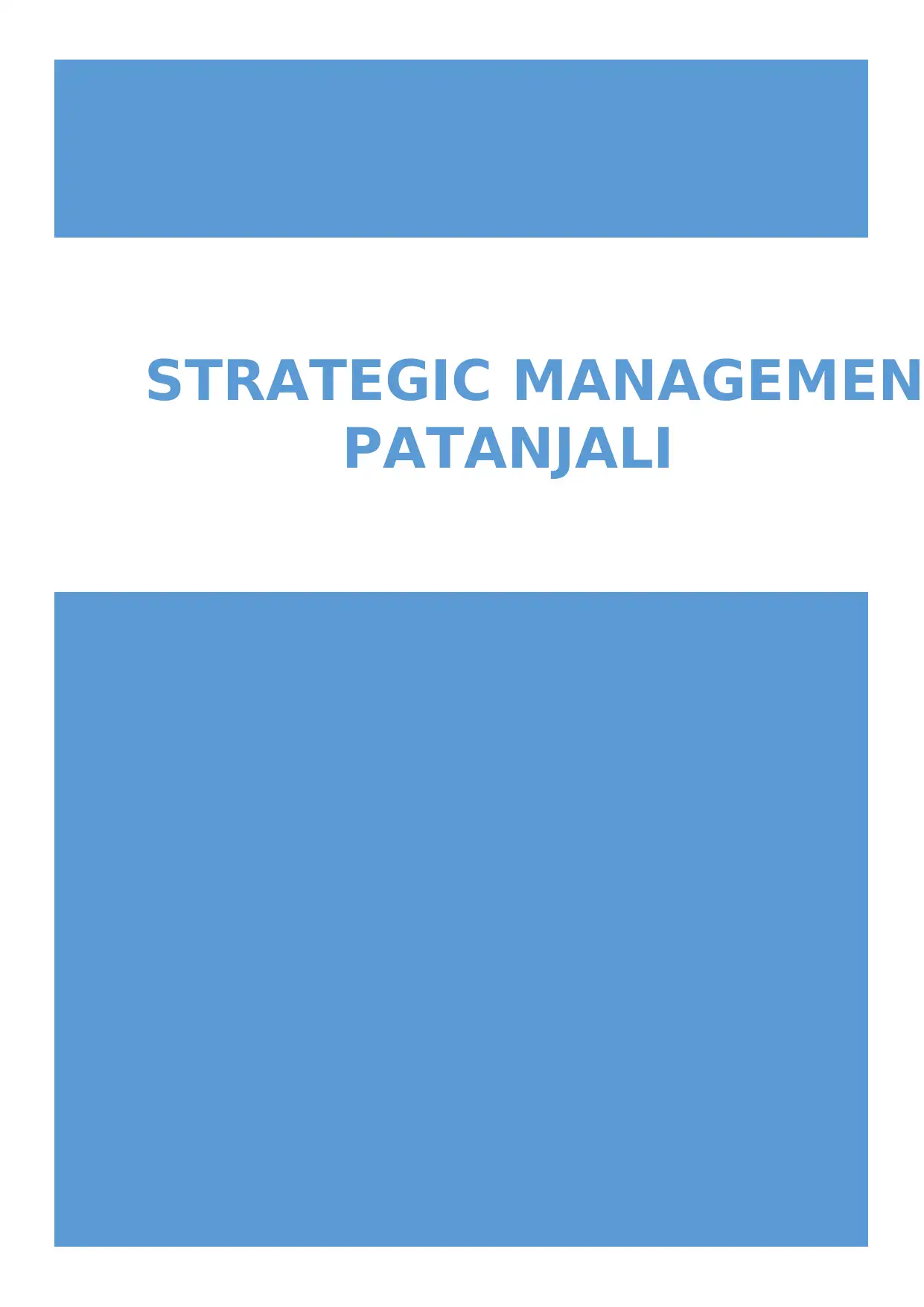
STRATEGIC MANAGEMEN
PATANJALI
PATANJALI
Paraphrase This Document
Need a fresh take? Get an instant paraphrase of this document with our AI Paraphraser
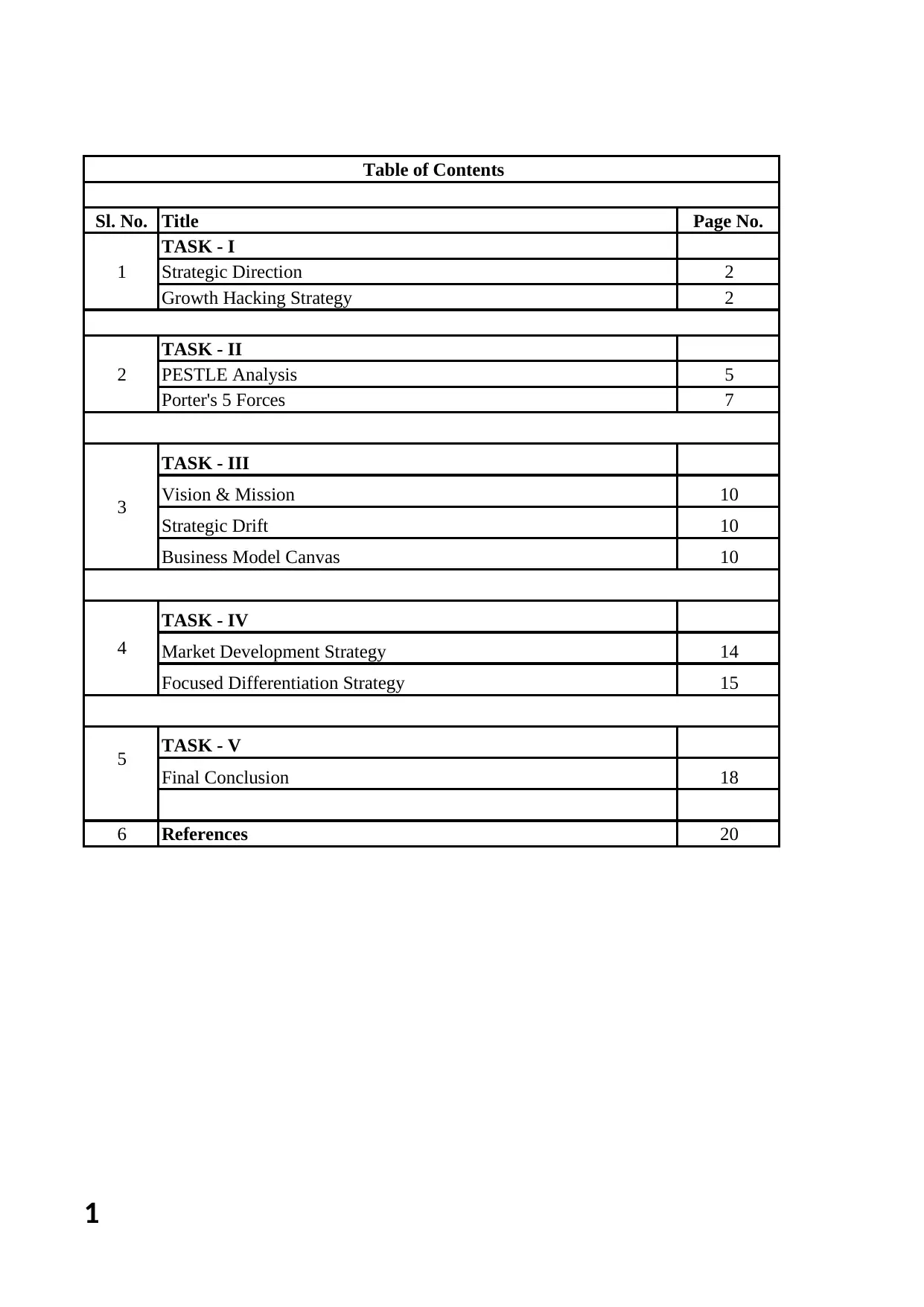
1
Sl. No. Page No.
TASK - I
2
2
TASK - II
5
7
TASK - III
10
10
10
TASK - IV
14
15
TASK - V
18
6 References 20
2
3
Table of Contents
Title
1 Strategic Direction
Growth Hacking Strategy
Market Development Strategy4
5
Focused Differentiation Strategy
Final Conclusion
PESTLE Analysis
Porter's 5 Forces
Vision & Mission
Strategic Drift
Business Model Canvas
Sl. No. Page No.
TASK - I
2
2
TASK - II
5
7
TASK - III
10
10
10
TASK - IV
14
15
TASK - V
18
6 References 20
2
3
Table of Contents
Title
1 Strategic Direction
Growth Hacking Strategy
Market Development Strategy4
5
Focused Differentiation Strategy
Final Conclusion
PESTLE Analysis
Porter's 5 Forces
Vision & Mission
Strategic Drift
Business Model Canvas
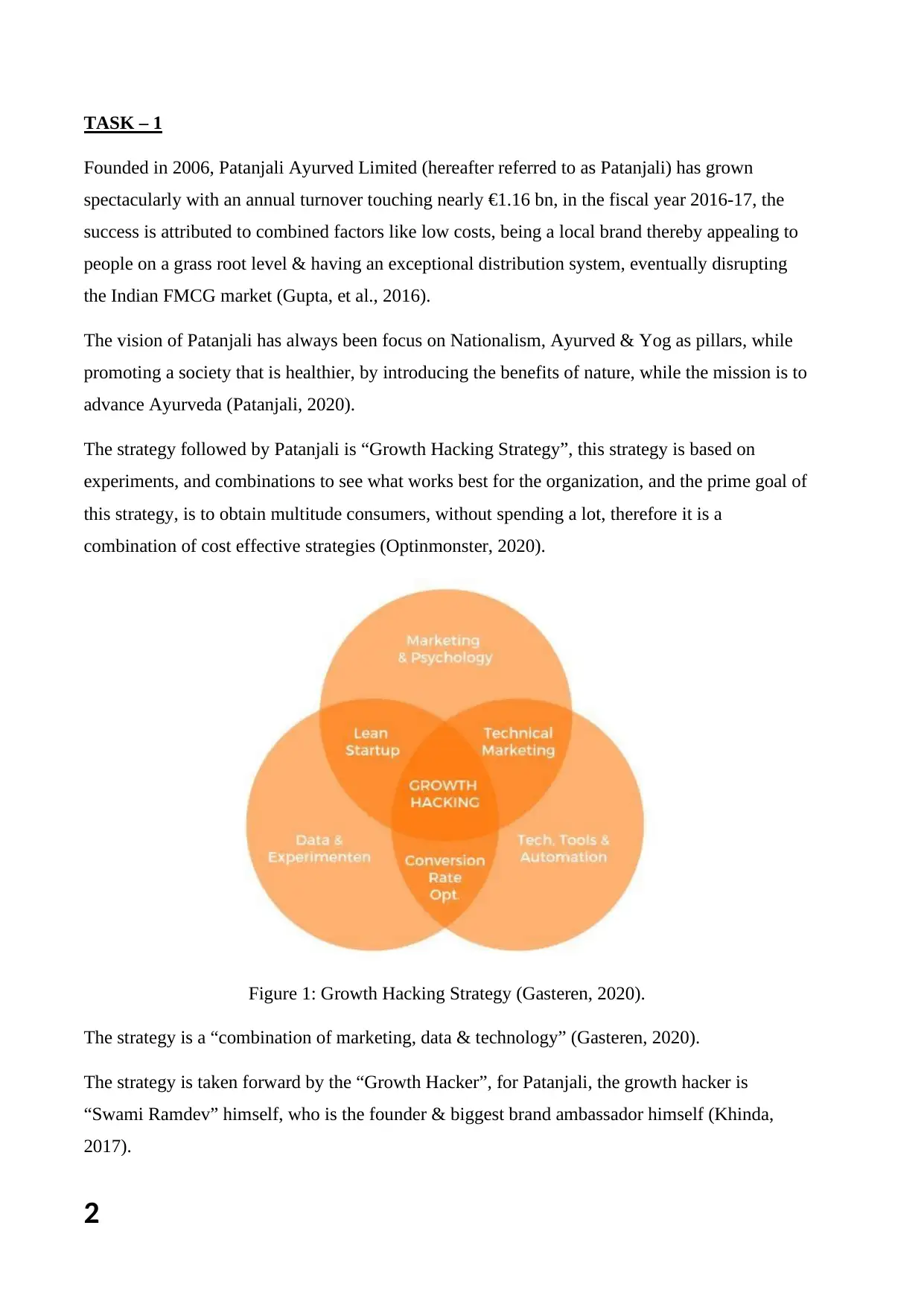
2
TASK – 1
Founded in 2006, Patanjali Ayurved Limited (hereafter referred to as Patanjali) has grown
spectacularly with an annual turnover touching nearly €1.16 bn, in the fiscal year 2016-17, the
success is attributed to combined factors like low costs, being a local brand thereby appealing to
people on a grass root level & having an exceptional distribution system, eventually disrupting
the Indian FMCG market (Gupta, et al., 2016).
The vision of Patanjali has always been focus on Nationalism, Ayurved & Yog as pillars, while
promoting a society that is healthier, by introducing the benefits of nature, while the mission is to
advance Ayurveda (Patanjali, 2020).
The strategy followed by Patanjali is “Growth Hacking Strategy”, this strategy is based on
experiments, and combinations to see what works best for the organization, and the prime goal of
this strategy, is to obtain multitude consumers, without spending a lot, therefore it is a
combination of cost effective strategies (Optinmonster, 2020).
Figure 1: Growth Hacking Strategy (Gasteren, 2020).
The strategy is a “combination of marketing, data & technology” (Gasteren, 2020).
The strategy is taken forward by the “Growth Hacker”, for Patanjali, the growth hacker is
“Swami Ramdev” himself, who is the founder & biggest brand ambassador himself (Khinda,
2017).
TASK – 1
Founded in 2006, Patanjali Ayurved Limited (hereafter referred to as Patanjali) has grown
spectacularly with an annual turnover touching nearly €1.16 bn, in the fiscal year 2016-17, the
success is attributed to combined factors like low costs, being a local brand thereby appealing to
people on a grass root level & having an exceptional distribution system, eventually disrupting
the Indian FMCG market (Gupta, et al., 2016).
The vision of Patanjali has always been focus on Nationalism, Ayurved & Yog as pillars, while
promoting a society that is healthier, by introducing the benefits of nature, while the mission is to
advance Ayurveda (Patanjali, 2020).
The strategy followed by Patanjali is “Growth Hacking Strategy”, this strategy is based on
experiments, and combinations to see what works best for the organization, and the prime goal of
this strategy, is to obtain multitude consumers, without spending a lot, therefore it is a
combination of cost effective strategies (Optinmonster, 2020).
Figure 1: Growth Hacking Strategy (Gasteren, 2020).
The strategy is a “combination of marketing, data & technology” (Gasteren, 2020).
The strategy is taken forward by the “Growth Hacker”, for Patanjali, the growth hacker is
“Swami Ramdev” himself, who is the founder & biggest brand ambassador himself (Khinda,
2017).
⊘ This is a preview!⊘
Do you want full access?
Subscribe today to unlock all pages.

Trusted by 1+ million students worldwide
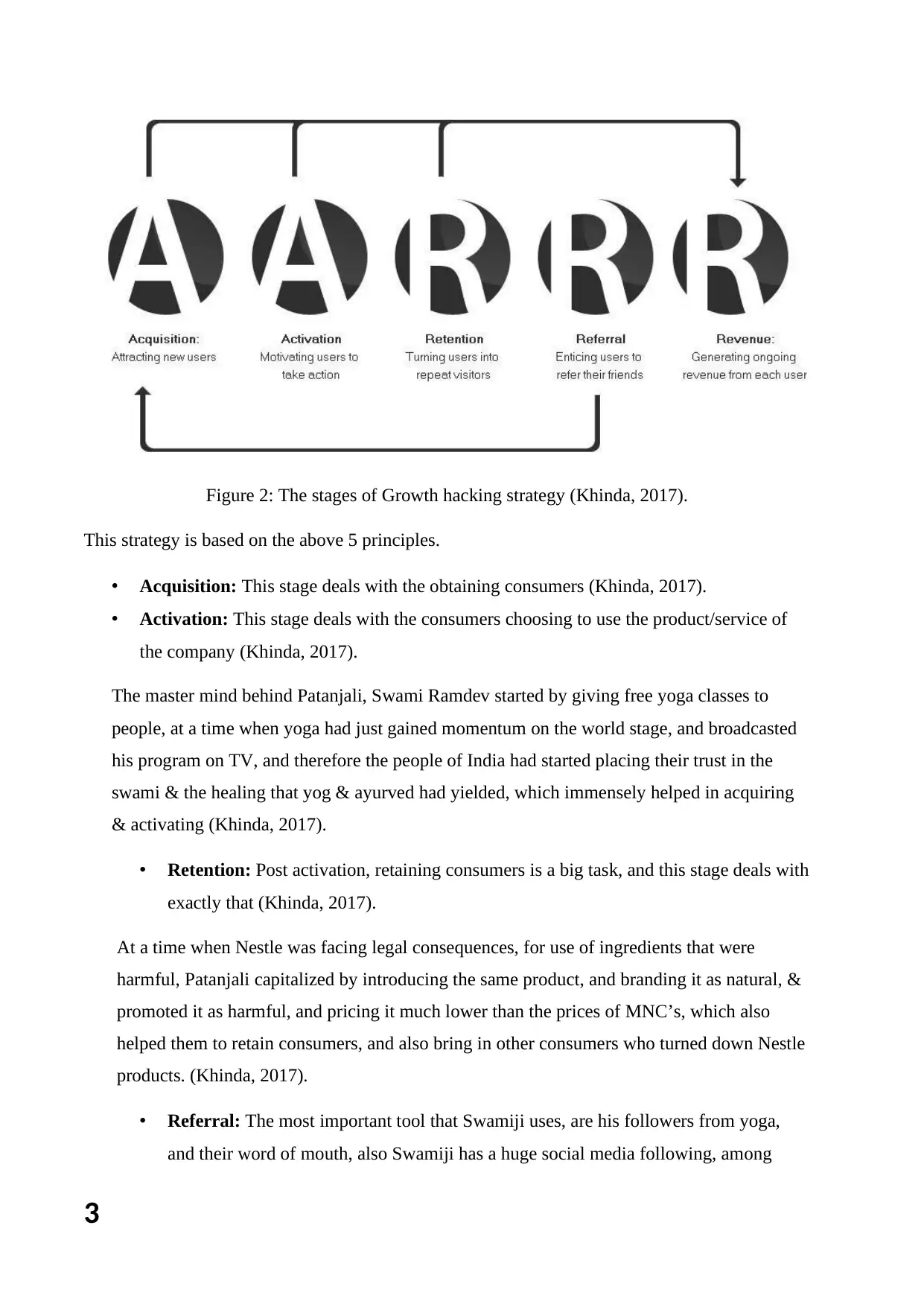
3
Figure 2: The stages of Growth hacking strategy (Khinda, 2017).
This strategy is based on the above 5 principles.
• Acquisition: This stage deals with the obtaining consumers (Khinda, 2017).
• Activation: This stage deals with the consumers choosing to use the product/service of
the company (Khinda, 2017).
The master mind behind Patanjali, Swami Ramdev started by giving free yoga classes to
people, at a time when yoga had just gained momentum on the world stage, and broadcasted
his program on TV, and therefore the people of India had started placing their trust in the
swami & the healing that yog & ayurved had yielded, which immensely helped in acquiring
& activating (Khinda, 2017).
• Retention: Post activation, retaining consumers is a big task, and this stage deals with
exactly that (Khinda, 2017).
At a time when Nestle was facing legal consequences, for use of ingredients that were
harmful, Patanjali capitalized by introducing the same product, and branding it as natural, &
promoted it as harmful, and pricing it much lower than the prices of MNC’s, which also
helped them to retain consumers, and also bring in other consumers who turned down Nestle
products. (Khinda, 2017).
• Referral: The most important tool that Swamiji uses, are his followers from yoga,
and their word of mouth, also Swamiji has a huge social media following, among
Figure 2: The stages of Growth hacking strategy (Khinda, 2017).
This strategy is based on the above 5 principles.
• Acquisition: This stage deals with the obtaining consumers (Khinda, 2017).
• Activation: This stage deals with the consumers choosing to use the product/service of
the company (Khinda, 2017).
The master mind behind Patanjali, Swami Ramdev started by giving free yoga classes to
people, at a time when yoga had just gained momentum on the world stage, and broadcasted
his program on TV, and therefore the people of India had started placing their trust in the
swami & the healing that yog & ayurved had yielded, which immensely helped in acquiring
& activating (Khinda, 2017).
• Retention: Post activation, retaining consumers is a big task, and this stage deals with
exactly that (Khinda, 2017).
At a time when Nestle was facing legal consequences, for use of ingredients that were
harmful, Patanjali capitalized by introducing the same product, and branding it as natural, &
promoted it as harmful, and pricing it much lower than the prices of MNC’s, which also
helped them to retain consumers, and also bring in other consumers who turned down Nestle
products. (Khinda, 2017).
• Referral: The most important tool that Swamiji uses, are his followers from yoga,
and their word of mouth, also Swamiji has a huge social media following, among
Paraphrase This Document
Need a fresh take? Get an instant paraphrase of this document with our AI Paraphraser
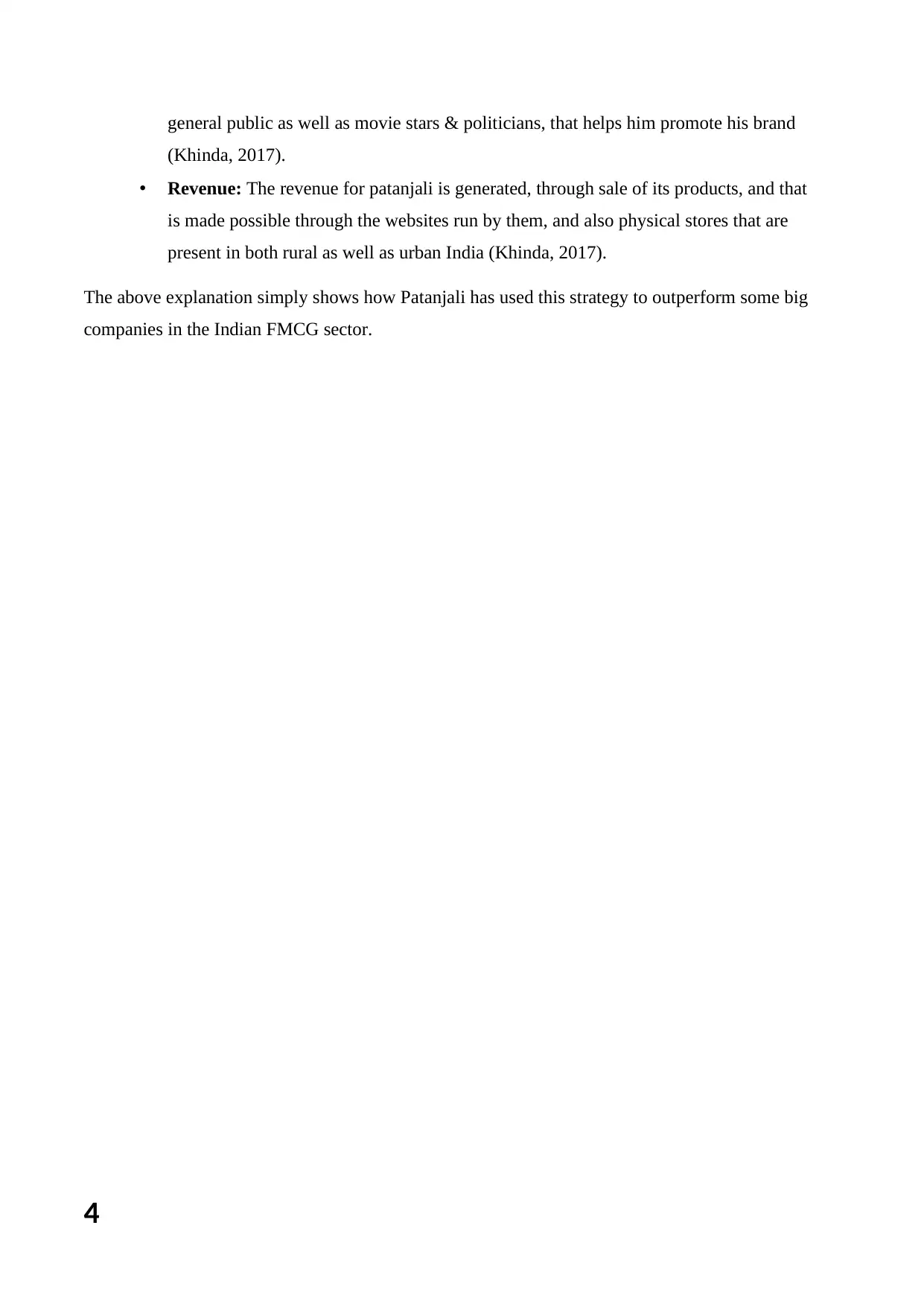
4
general public as well as movie stars & politicians, that helps him promote his brand
(Khinda, 2017).
• Revenue: The revenue for patanjali is generated, through sale of its products, and that
is made possible through the websites run by them, and also physical stores that are
present in both rural as well as urban India (Khinda, 2017).
The above explanation simply shows how Patanjali has used this strategy to outperform some big
companies in the Indian FMCG sector.
general public as well as movie stars & politicians, that helps him promote his brand
(Khinda, 2017).
• Revenue: The revenue for patanjali is generated, through sale of its products, and that
is made possible through the websites run by them, and also physical stores that are
present in both rural as well as urban India (Khinda, 2017).
The above explanation simply shows how Patanjali has used this strategy to outperform some big
companies in the Indian FMCG sector.
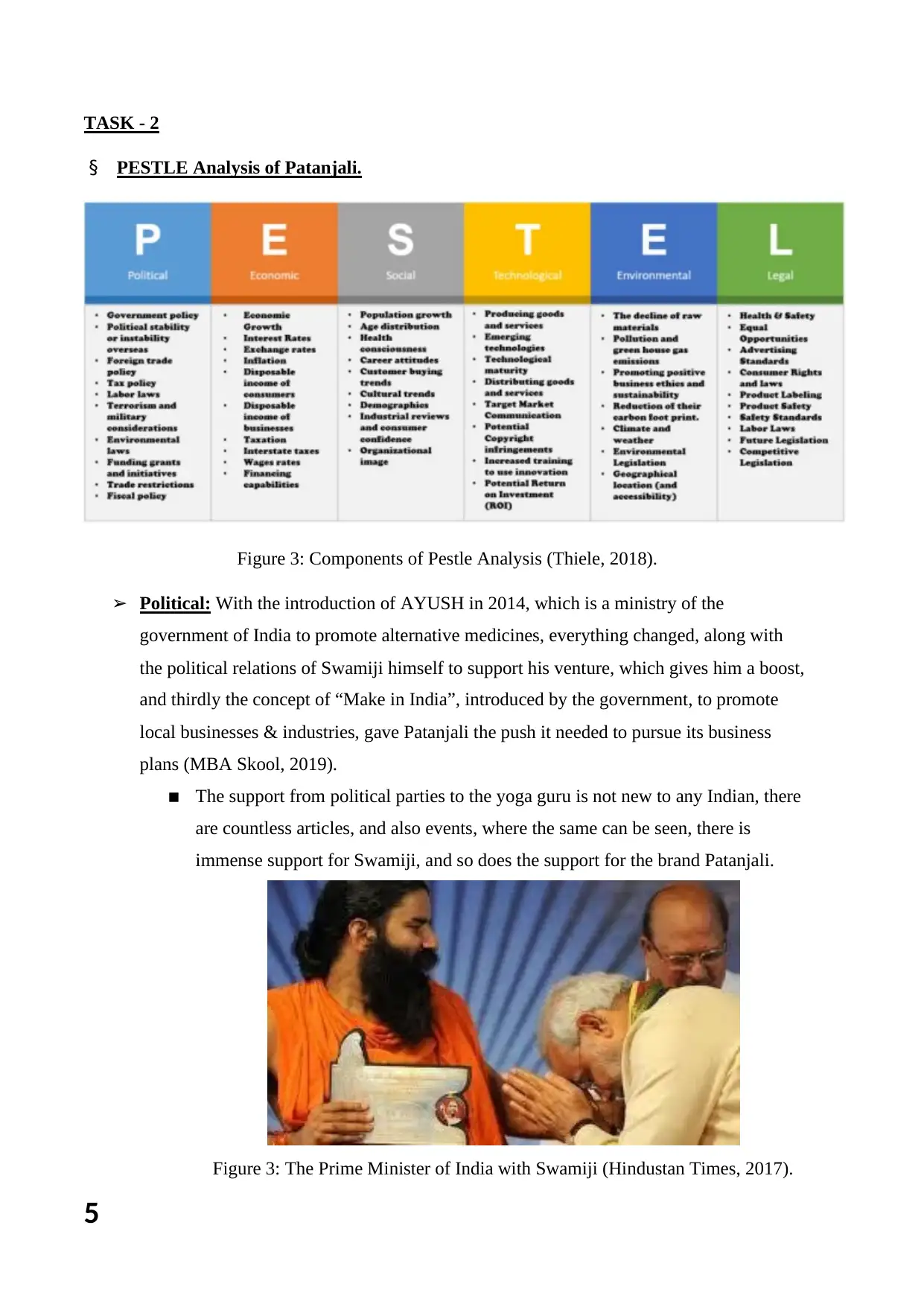
5
TASK - 2
§ PESTLE Analysis of Patanjali.
Figure 3: Components of Pestle Analysis (Thiele, 2018).
➢ Political: With the introduction of AYUSH in 2014, which is a ministry of the
government of India to promote alternative medicines, everything changed, along with
the political relations of Swamiji himself to support his venture, which gives him a boost,
and thirdly the concept of “Make in India”, introduced by the government, to promote
local businesses & industries, gave Patanjali the push it needed to pursue its business
plans (MBA Skool, 2019).
▪ The support from political parties to the yoga guru is not new to any Indian, there
are countless articles, and also events, where the same can be seen, there is
immense support for Swamiji, and so does the support for the brand Patanjali.
Figure 3: The Prime Minister of India with Swamiji (Hindustan Times, 2017).
TASK - 2
§ PESTLE Analysis of Patanjali.
Figure 3: Components of Pestle Analysis (Thiele, 2018).
➢ Political: With the introduction of AYUSH in 2014, which is a ministry of the
government of India to promote alternative medicines, everything changed, along with
the political relations of Swamiji himself to support his venture, which gives him a boost,
and thirdly the concept of “Make in India”, introduced by the government, to promote
local businesses & industries, gave Patanjali the push it needed to pursue its business
plans (MBA Skool, 2019).
▪ The support from political parties to the yoga guru is not new to any Indian, there
are countless articles, and also events, where the same can be seen, there is
immense support for Swamiji, and so does the support for the brand Patanjali.
Figure 3: The Prime Minister of India with Swamiji (Hindustan Times, 2017).
⊘ This is a preview!⊘
Do you want full access?
Subscribe today to unlock all pages.

Trusted by 1+ million students worldwide
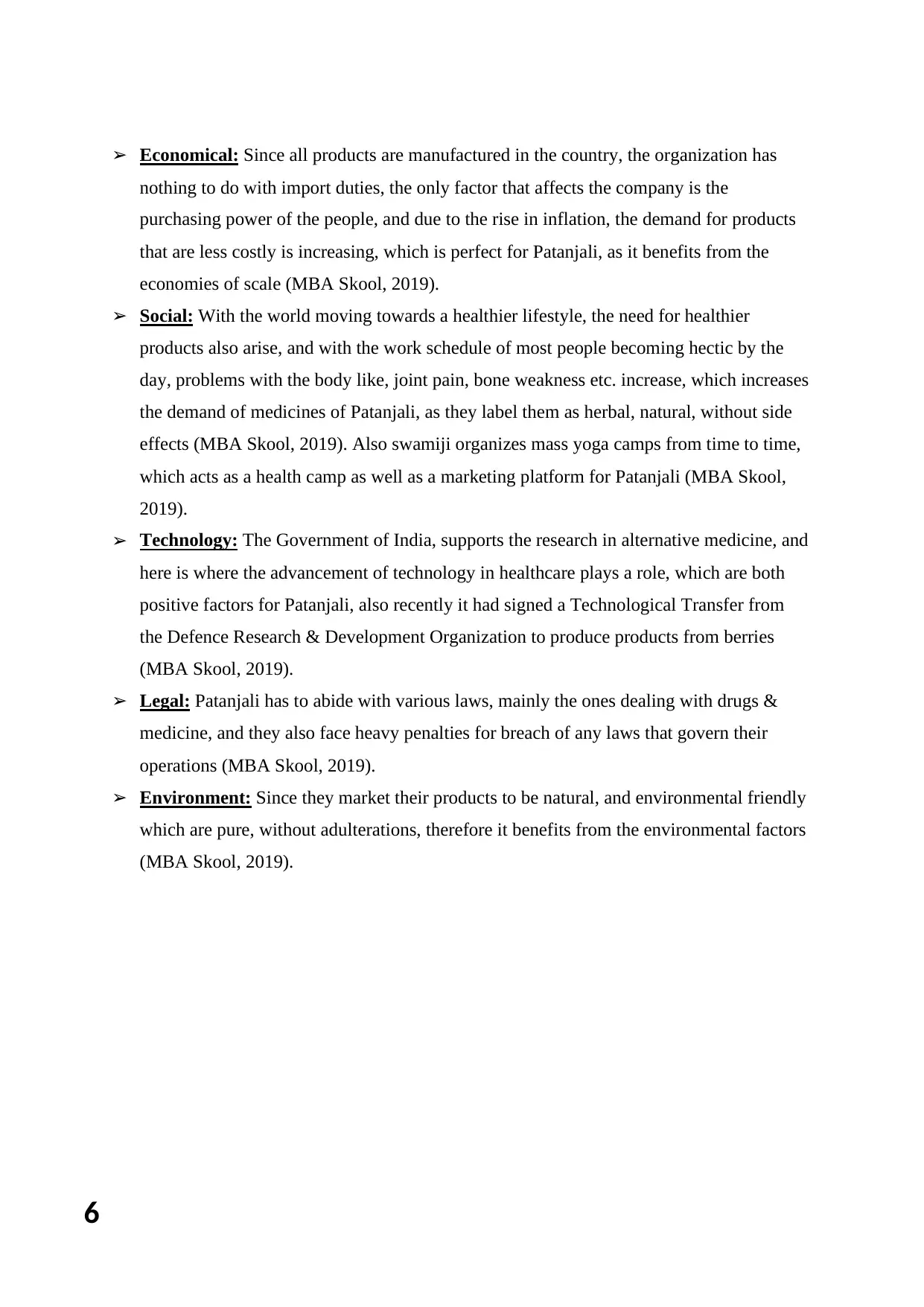
6
➢ Economical: Since all products are manufactured in the country, the organization has
nothing to do with import duties, the only factor that affects the company is the
purchasing power of the people, and due to the rise in inflation, the demand for products
that are less costly is increasing, which is perfect for Patanjali, as it benefits from the
economies of scale (MBA Skool, 2019).
➢ Social: With the world moving towards a healthier lifestyle, the need for healthier
products also arise, and with the work schedule of most people becoming hectic by the
day, problems with the body like, joint pain, bone weakness etc. increase, which increases
the demand of medicines of Patanjali, as they label them as herbal, natural, without side
effects (MBA Skool, 2019). Also swamiji organizes mass yoga camps from time to time,
which acts as a health camp as well as a marketing platform for Patanjali (MBA Skool,
2019).
➢ Technology: The Government of India, supports the research in alternative medicine, and
here is where the advancement of technology in healthcare plays a role, which are both
positive factors for Patanjali, also recently it had signed a Technological Transfer from
the Defence Research & Development Organization to produce products from berries
(MBA Skool, 2019).
➢ Legal: Patanjali has to abide with various laws, mainly the ones dealing with drugs &
medicine, and they also face heavy penalties for breach of any laws that govern their
operations (MBA Skool, 2019).
➢ Environment: Since they market their products to be natural, and environmental friendly
which are pure, without adulterations, therefore it benefits from the environmental factors
(MBA Skool, 2019).
➢ Economical: Since all products are manufactured in the country, the organization has
nothing to do with import duties, the only factor that affects the company is the
purchasing power of the people, and due to the rise in inflation, the demand for products
that are less costly is increasing, which is perfect for Patanjali, as it benefits from the
economies of scale (MBA Skool, 2019).
➢ Social: With the world moving towards a healthier lifestyle, the need for healthier
products also arise, and with the work schedule of most people becoming hectic by the
day, problems with the body like, joint pain, bone weakness etc. increase, which increases
the demand of medicines of Patanjali, as they label them as herbal, natural, without side
effects (MBA Skool, 2019). Also swamiji organizes mass yoga camps from time to time,
which acts as a health camp as well as a marketing platform for Patanjali (MBA Skool,
2019).
➢ Technology: The Government of India, supports the research in alternative medicine, and
here is where the advancement of technology in healthcare plays a role, which are both
positive factors for Patanjali, also recently it had signed a Technological Transfer from
the Defence Research & Development Organization to produce products from berries
(MBA Skool, 2019).
➢ Legal: Patanjali has to abide with various laws, mainly the ones dealing with drugs &
medicine, and they also face heavy penalties for breach of any laws that govern their
operations (MBA Skool, 2019).
➢ Environment: Since they market their products to be natural, and environmental friendly
which are pure, without adulterations, therefore it benefits from the environmental factors
(MBA Skool, 2019).
Paraphrase This Document
Need a fresh take? Get an instant paraphrase of this document with our AI Paraphraser
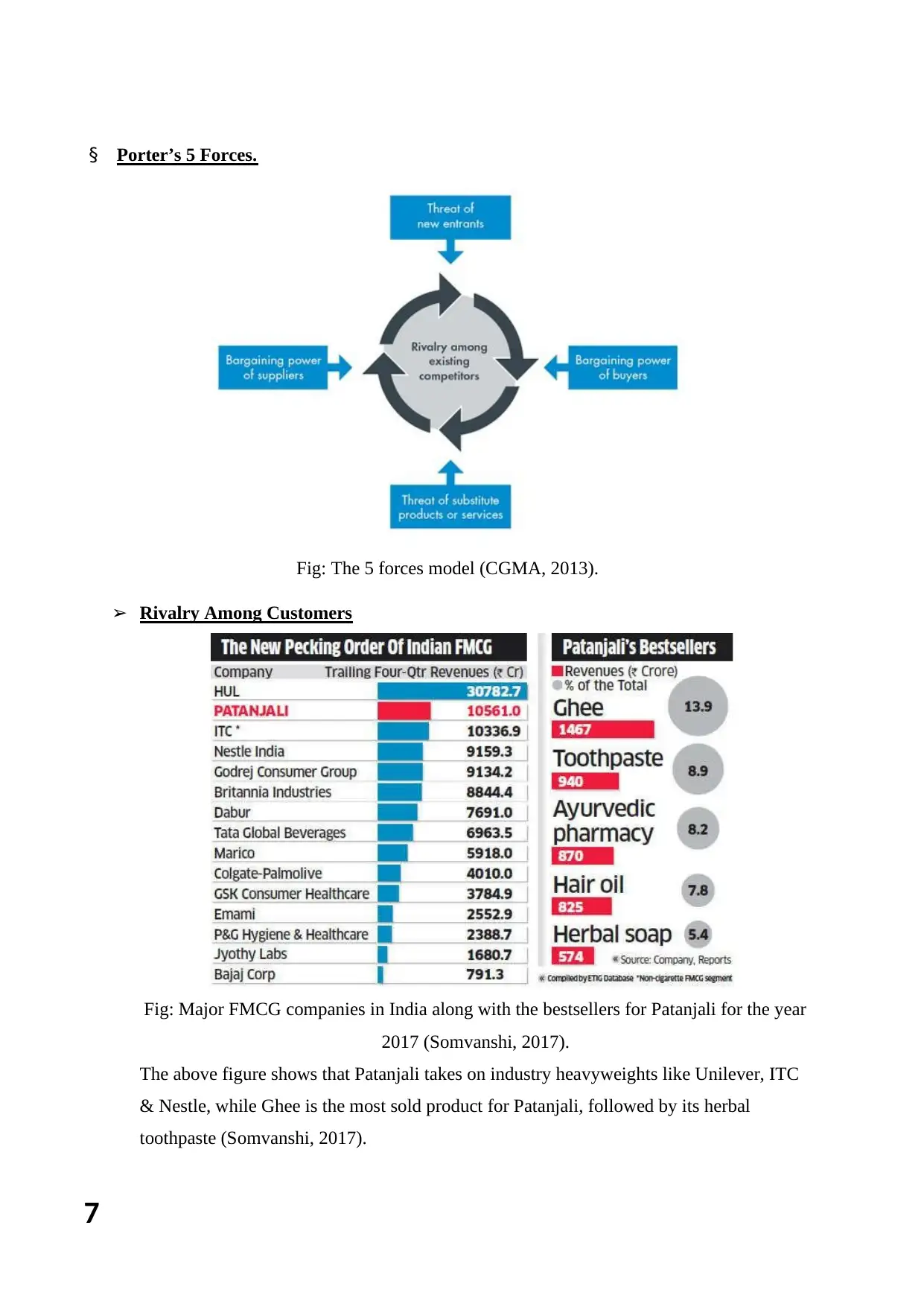
7
§ Porter’s 5 Forces.
Fig: The 5 forces model (CGMA, 2013).
➢ Rivalry Among Customers
Fig: Major FMCG companies in India along with the bestsellers for Patanjali for the year
2017 (Somvanshi, 2017).
The above figure shows that Patanjali takes on industry heavyweights like Unilever, ITC
& Nestle, while Ghee is the most sold product for Patanjali, followed by its herbal
toothpaste (Somvanshi, 2017).
§ Porter’s 5 Forces.
Fig: The 5 forces model (CGMA, 2013).
➢ Rivalry Among Customers
Fig: Major FMCG companies in India along with the bestsellers for Patanjali for the year
2017 (Somvanshi, 2017).
The above figure shows that Patanjali takes on industry heavyweights like Unilever, ITC
& Nestle, while Ghee is the most sold product for Patanjali, followed by its herbal
toothpaste (Somvanshi, 2017).
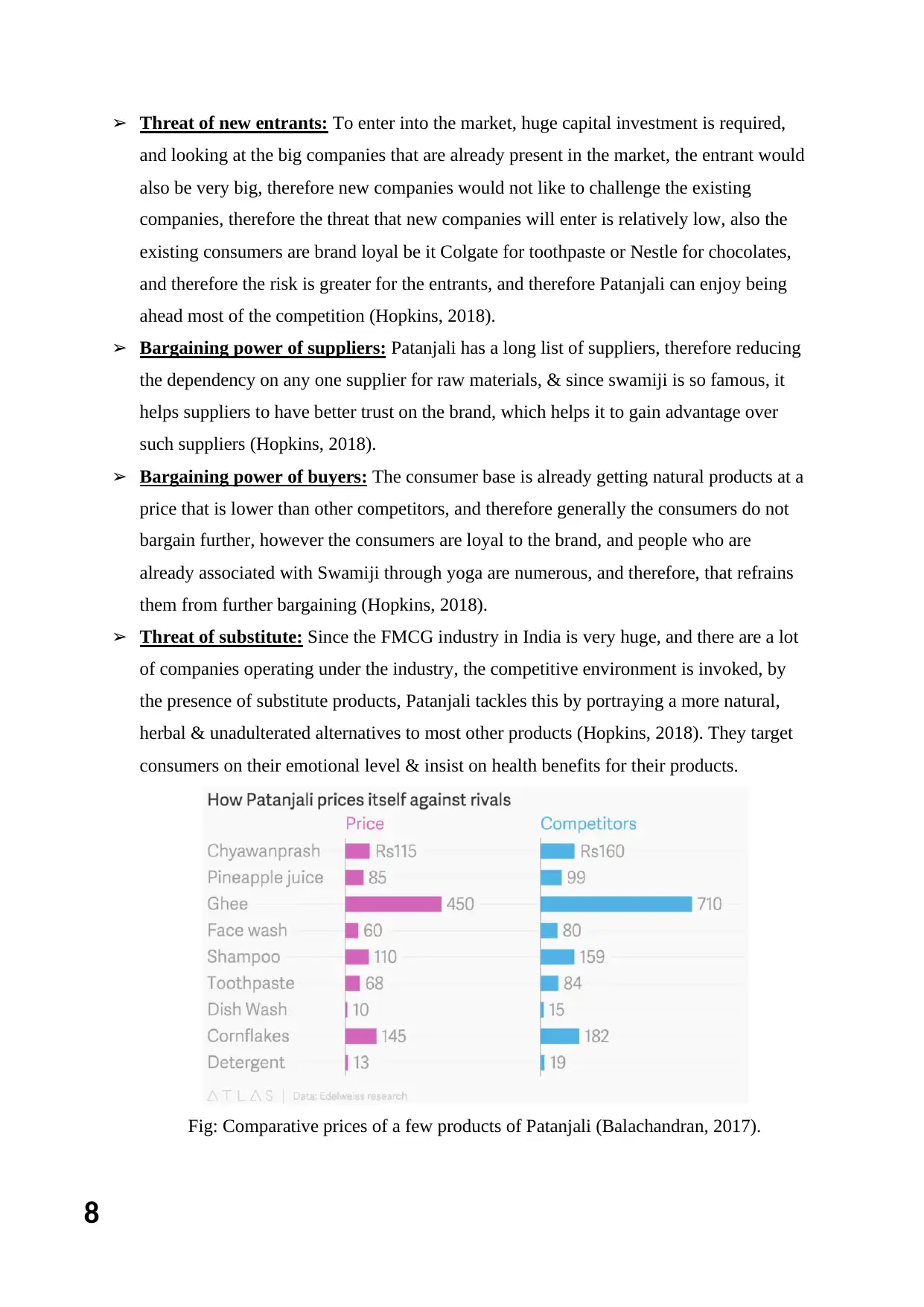
8
➢ Threat of new entrants: To enter into the market, huge capital investment is required,
and looking at the big companies that are already present in the market, the entrant would
also be very big, therefore new companies would not like to challenge the existing
companies, therefore the threat that new companies will enter is relatively low, also the
existing consumers are brand loyal be it Colgate for toothpaste or Nestle for chocolates,
and therefore the risk is greater for the entrants, and therefore Patanjali can enjoy being
ahead most of the competition (Hopkins, 2018).
➢ Bargaining power of suppliers: Patanjali has a long list of suppliers, therefore reducing
the dependency on any one supplier for raw materials, & since swamiji is so famous, it
helps suppliers to have better trust on the brand, which helps it to gain advantage over
such suppliers (Hopkins, 2018).
➢ Bargaining power of buyers: The consumer base is already getting natural products at a
price that is lower than other competitors, and therefore generally the consumers do not
bargain further, however the consumers are loyal to the brand, and people who are
already associated with Swamiji through yoga are numerous, and therefore, that refrains
them from further bargaining (Hopkins, 2018).
➢ Threat of substitute: Since the FMCG industry in India is very huge, and there are a lot
of companies operating under the industry, the competitive environment is invoked, by
the presence of substitute products, Patanjali tackles this by portraying a more natural,
herbal & unadulterated alternatives to most other products (Hopkins, 2018). They target
consumers on their emotional level & insist on health benefits for their products.
Fig: Comparative prices of a few products of Patanjali (Balachandran, 2017).
➢ Threat of new entrants: To enter into the market, huge capital investment is required,
and looking at the big companies that are already present in the market, the entrant would
also be very big, therefore new companies would not like to challenge the existing
companies, therefore the threat that new companies will enter is relatively low, also the
existing consumers are brand loyal be it Colgate for toothpaste or Nestle for chocolates,
and therefore the risk is greater for the entrants, and therefore Patanjali can enjoy being
ahead most of the competition (Hopkins, 2018).
➢ Bargaining power of suppliers: Patanjali has a long list of suppliers, therefore reducing
the dependency on any one supplier for raw materials, & since swamiji is so famous, it
helps suppliers to have better trust on the brand, which helps it to gain advantage over
such suppliers (Hopkins, 2018).
➢ Bargaining power of buyers: The consumer base is already getting natural products at a
price that is lower than other competitors, and therefore generally the consumers do not
bargain further, however the consumers are loyal to the brand, and people who are
already associated with Swamiji through yoga are numerous, and therefore, that refrains
them from further bargaining (Hopkins, 2018).
➢ Threat of substitute: Since the FMCG industry in India is very huge, and there are a lot
of companies operating under the industry, the competitive environment is invoked, by
the presence of substitute products, Patanjali tackles this by portraying a more natural,
herbal & unadulterated alternatives to most other products (Hopkins, 2018). They target
consumers on their emotional level & insist on health benefits for their products.
Fig: Comparative prices of a few products of Patanjali (Balachandran, 2017).
⊘ This is a preview!⊘
Do you want full access?
Subscribe today to unlock all pages.

Trusted by 1+ million students worldwide

9
From the above figure we can conclude that most of the substitute products of Patanjali
are priced higher than those provided by Patanjali, & therefore Patanjali enjoys
competitor dominance in the industry.
From the above figure we can conclude that most of the substitute products of Patanjali
are priced higher than those provided by Patanjali, & therefore Patanjali enjoys
competitor dominance in the industry.
Paraphrase This Document
Need a fresh take? Get an instant paraphrase of this document with our AI Paraphraser
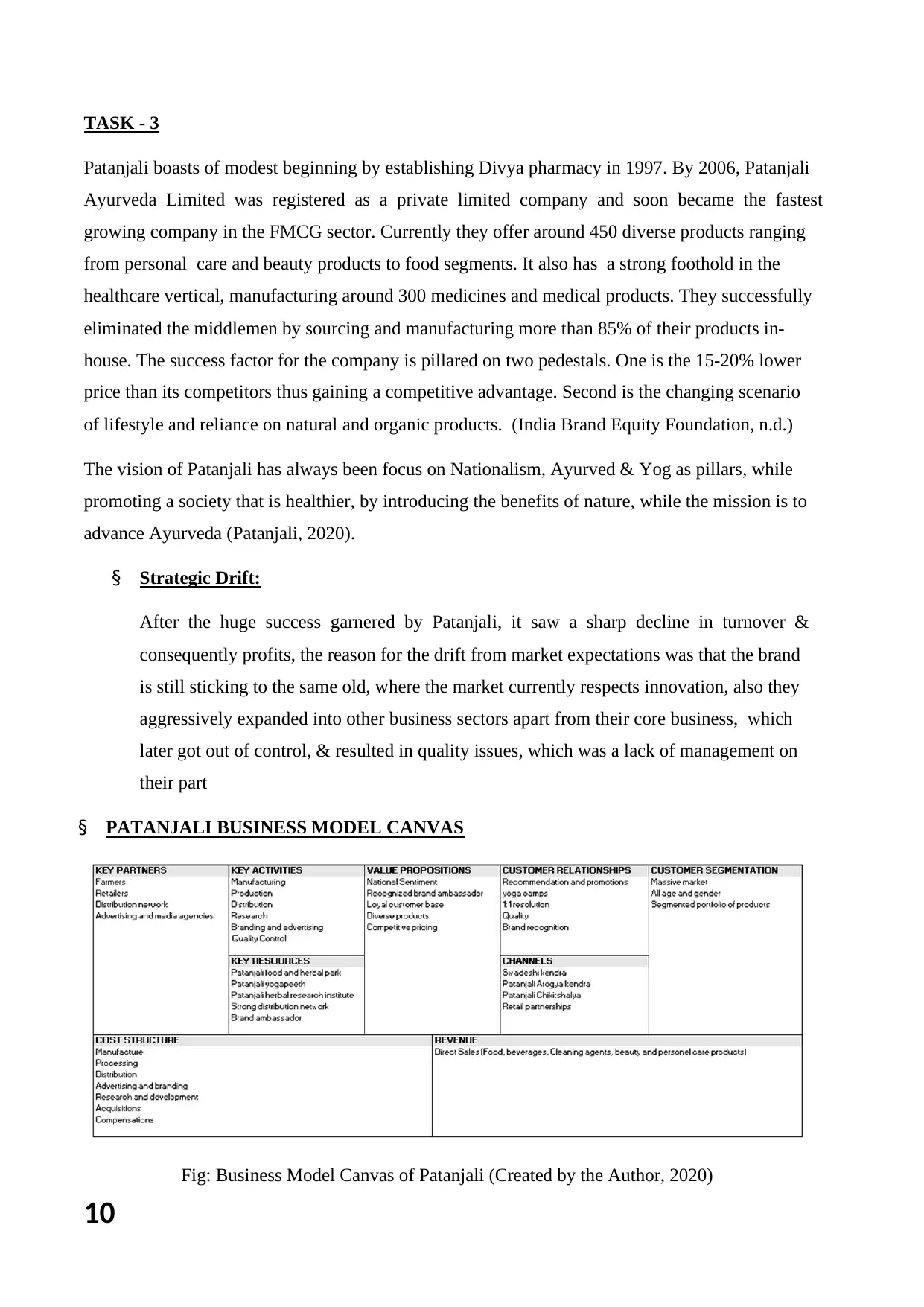
10
TASK - 3
Patanjali boasts of modest beginning by establishing Divya pharmacy in 1997. By 2006, Patanjali
Ayurveda Limited was registered as a private limited company and soon became the fastest
growing company in the FMCG sector. Currently they offer around 450 diverse products ranging
from personal care and beauty products to food segments. It also has a strong foothold in the
healthcare vertical, manufacturing around 300 medicines and medical products. They successfully
eliminated the middlemen by sourcing and manufacturing more than 85% of their products in-
house. The success factor for the company is pillared on two pedestals. One is the 15-20% lower
price than its competitors thus gaining a competitive advantage. Second is the changing scenario
of lifestyle and reliance on natural and organic products. (India Brand Equity Foundation, n.d.)
The vision of Patanjali has always been focus on Nationalism, Ayurved & Yog as pillars, while
promoting a society that is healthier, by introducing the benefits of nature, while the mission is to
advance Ayurveda (Patanjali, 2020).
§ Strategic Drift:
After the huge success garnered by Patanjali, it saw a sharp decline in turnover &
consequently profits, the reason for the drift from market expectations was that the brand
is still sticking to the same old, where the market currently respects innovation, also they
aggressively expanded into other business sectors apart from their core business, which
later got out of control, & resulted in quality issues, which was a lack of management on
their part
§ PATANJALI BUSINESS MODEL CANVAS
Fig: Business Model Canvas of Patanjali (Created by the Author, 2020)
TASK - 3
Patanjali boasts of modest beginning by establishing Divya pharmacy in 1997. By 2006, Patanjali
Ayurveda Limited was registered as a private limited company and soon became the fastest
growing company in the FMCG sector. Currently they offer around 450 diverse products ranging
from personal care and beauty products to food segments. It also has a strong foothold in the
healthcare vertical, manufacturing around 300 medicines and medical products. They successfully
eliminated the middlemen by sourcing and manufacturing more than 85% of their products in-
house. The success factor for the company is pillared on two pedestals. One is the 15-20% lower
price than its competitors thus gaining a competitive advantage. Second is the changing scenario
of lifestyle and reliance on natural and organic products. (India Brand Equity Foundation, n.d.)
The vision of Patanjali has always been focus on Nationalism, Ayurved & Yog as pillars, while
promoting a society that is healthier, by introducing the benefits of nature, while the mission is to
advance Ayurveda (Patanjali, 2020).
§ Strategic Drift:
After the huge success garnered by Patanjali, it saw a sharp decline in turnover &
consequently profits, the reason for the drift from market expectations was that the brand
is still sticking to the same old, where the market currently respects innovation, also they
aggressively expanded into other business sectors apart from their core business, which
later got out of control, & resulted in quality issues, which was a lack of management on
their part
§ PATANJALI BUSINESS MODEL CANVAS
Fig: Business Model Canvas of Patanjali (Created by the Author, 2020)
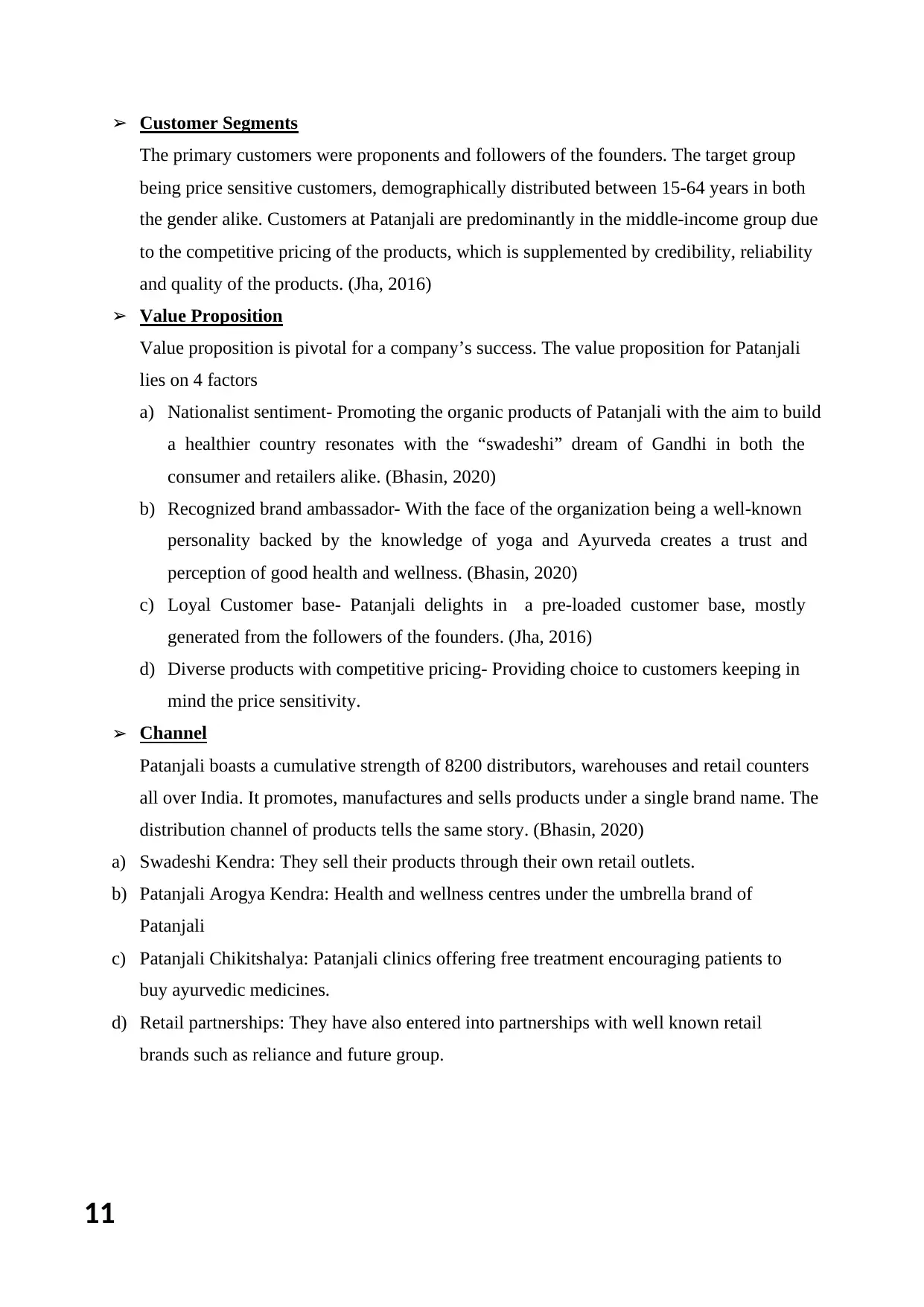
11
➢ Customer Segments
The primary customers were proponents and followers of the founders. The target group
being price sensitive customers, demographically distributed between 15-64 years in both
the gender alike. Customers at Patanjali are predominantly in the middle-income group due
to the competitive pricing of the products, which is supplemented by credibility, reliability
and quality of the products. (Jha, 2016)
➢ Value Proposition
Value proposition is pivotal for a company’s success. The value proposition for Patanjali
lies on 4 factors
a) Nationalist sentiment- Promoting the organic products of Patanjali with the aim to build
a healthier country resonates with the “swadeshi” dream of Gandhi in both the
consumer and retailers alike. (Bhasin, 2020)
b) Recognized brand ambassador- With the face of the organization being a well-known
personality backed by the knowledge of yoga and Ayurveda creates a trust and
perception of good health and wellness. (Bhasin, 2020)
c) Loyal Customer base- Patanjali delights in a pre-loaded customer base, mostly
generated from the followers of the founders. (Jha, 2016)
d) Diverse products with competitive pricing- Providing choice to customers keeping in
mind the price sensitivity.
➢ Channel
Patanjali boasts a cumulative strength of 8200 distributors, warehouses and retail counters
all over India. It promotes, manufactures and sells products under a single brand name. The
distribution channel of products tells the same story. (Bhasin, 2020)
a) Swadeshi Kendra: They sell their products through their own retail outlets.
b) Patanjali Arogya Kendra: Health and wellness centres under the umbrella brand of
Patanjali
c) Patanjali Chikitshalya: Patanjali clinics offering free treatment encouraging patients to
buy ayurvedic medicines.
d) Retail partnerships: They have also entered into partnerships with well known retail
brands such as reliance and future group.
➢ Customer Segments
The primary customers were proponents and followers of the founders. The target group
being price sensitive customers, demographically distributed between 15-64 years in both
the gender alike. Customers at Patanjali are predominantly in the middle-income group due
to the competitive pricing of the products, which is supplemented by credibility, reliability
and quality of the products. (Jha, 2016)
➢ Value Proposition
Value proposition is pivotal for a company’s success. The value proposition for Patanjali
lies on 4 factors
a) Nationalist sentiment- Promoting the organic products of Patanjali with the aim to build
a healthier country resonates with the “swadeshi” dream of Gandhi in both the
consumer and retailers alike. (Bhasin, 2020)
b) Recognized brand ambassador- With the face of the organization being a well-known
personality backed by the knowledge of yoga and Ayurveda creates a trust and
perception of good health and wellness. (Bhasin, 2020)
c) Loyal Customer base- Patanjali delights in a pre-loaded customer base, mostly
generated from the followers of the founders. (Jha, 2016)
d) Diverse products with competitive pricing- Providing choice to customers keeping in
mind the price sensitivity.
➢ Channel
Patanjali boasts a cumulative strength of 8200 distributors, warehouses and retail counters
all over India. It promotes, manufactures and sells products under a single brand name. The
distribution channel of products tells the same story. (Bhasin, 2020)
a) Swadeshi Kendra: They sell their products through their own retail outlets.
b) Patanjali Arogya Kendra: Health and wellness centres under the umbrella brand of
Patanjali
c) Patanjali Chikitshalya: Patanjali clinics offering free treatment encouraging patients to
buy ayurvedic medicines.
d) Retail partnerships: They have also entered into partnerships with well known retail
brands such as reliance and future group.
⊘ This is a preview!⊘
Do you want full access?
Subscribe today to unlock all pages.

Trusted by 1+ million students worldwide
1 out of 22
Your All-in-One AI-Powered Toolkit for Academic Success.
+13062052269
info@desklib.com
Available 24*7 on WhatsApp / Email
![[object Object]](/_next/static/media/star-bottom.7253800d.svg)
Unlock your academic potential
Copyright © 2020–2025 A2Z Services. All Rights Reserved. Developed and managed by ZUCOL.